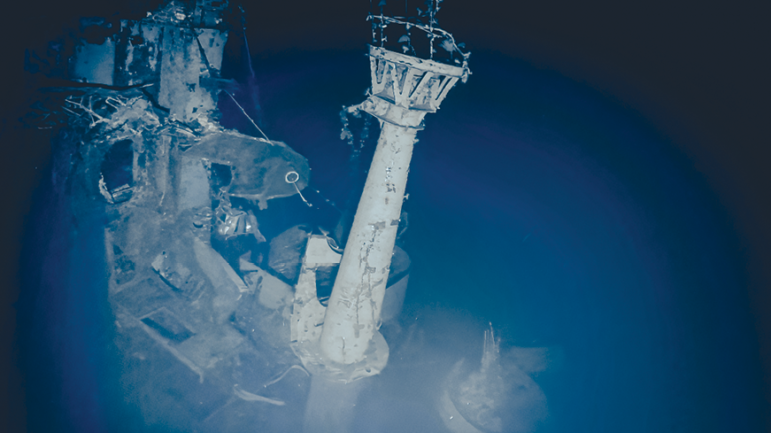
“The great depths of the ocean are totally unknown to us. Soundings cannot reach them. What transpires in those remote abysses– what beings live, or can live, twelve or fifteen miles beneath the surface of the waters…we can scarcely even guess.”
So said Dr Aronnax in Jules Vernes 20,000 Leagues Under the Sea when contemplating the seemingly unending and unknowable vastness of the ocean. For most of us, it’s a foreign place, but there is something of the familiar in it too, something harkening back to our own collective history. It was this history that inspired the seventh and eighth grade classes at Suffield Middle School as they listened in rapt attention to Science Communication Fellow Dan Kinzer, our guide to this incredible underwater world, discuss life aboard the E/V Nautilus, a modern version of Verne’s ship. Speaking live from its control room some 1,400 miles from Honolulu in the Papahānaumokuākea Maine National Monument, Dan showed how exploratory science can break down some of the unknowable mysteries of the world and allow us a better understanding of the dynamics that govern our planet. In fact, it was the E/V Nautilus’s captain, famed deep sea explorer Dr. Bob Ballard, who discovered both the ocean’s superheated hydrothermal vents and the communities of life around them (as well as being the man who found the Titanic). During Dan’s talk this September, he described how a mere 29% of the world’s oceans have been mapped and how the Nautilus, with its wide-angle sonar, is helping to change that. Students were able to watch captivating video footage of recently discovered deep sea communities living at over 15,000 feet of depth (including everyone’s favorite, the affable looking dumbo octopus), and witness in almost real time the first visual survey of Imperial Japanese Navy (IJN) Akagi, IJN Kaga, and the first detailed views of United States Ship (USS) Yorktown since it was first located 25 years ago, all sunk during the Battle of Midway. Now that’s some history!
Opportunities like this fall in the canon of something called experiential learning. Aptly titled, experiential learning (EL) is hands-on and works on the premise that we don’t passively absorb information, we construct learning through experience. As a field of research it has exploded. In fact, since the 1970s there have been over 90,000 EL citations, the number quadrupling since 2000. Why all the buzz? Well, the way I see it, EL is the way we naturally learn. All of us are doing it, all of the time. Watch a YouTube video on something that broke in your house, then use the information to fix it? That’s experiential learning. Burn some cookies, and adjust the heat for the second batch? That’s EL too. In the classroom, laboratory experiments, field trips, practicums where students gather data to reach independent conclusions, and writing code to operate robots are all examples of EL. In fact, as the remotely operated vehicle pilots on the E/V Nautilus searched for clues, interpreted them, and used that newly acquired information to modify their plans to locate the sunken hulls of those WWII aircraft carriers, those pilots were all employing EL. So were the students interacting with Dan, peppering him with questions as they learned about what the scientists aboard were discovering (and how they were going about discovering those things). It’s the type of learning that Suffield Public Schools are working to create more of.
As the district’s new K-12 Science Coach, my job is to infuse my passion for hands-on learning all over the district. So, what have we been up to? Outside of 15,000 feet under sea explorations, student leaders from the high school’s Suffield Sustainability Council are working with USA Recycling to create a K-12 composting program. Teaming up with elementary teachers, our students are designing educational materials that they themselves will teach the students as we pilot this program at Spaulding Elementary. What else? Well, we are working to design a field-based practicum for middle school students to apply their learning about ecosystems by analyzing stream life at the John and Madeline McClean Outdoor Education Preserve. We’re also planning a giant ‘bioblitz’ for students K-12 to team with scientists from all over Connecticut to explore as many types of life as possible – an activity that will show them that scientists don’t just wear white lab coats, some of them wear muck boots and are out there in the field exploring how this beautiful planet works. And after the presentation from the control room of the Nautilus, we started the Science Explorers Club for students at SMS to learn more about, well, whatever they want to. Since the consensus was definitely to learn more about the ocean, we are in contact with Project Oceanography as well as Dr Ballard’s lab at the University of Rhode Island to get our learners out there, experiencing it. Who knows, maybe the planet’s next great explorer is right here in Suffield, sitting in one of our classrooms, just waiting for the spark of inspiration to ignite their search for a deeper understanding.